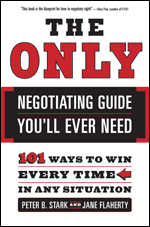Negotiating Desirable Outcomes
You may not realize it, but you are involved in negotiation a good part of every day. Any negotiation–whether it involves settling on the price of a product or service, agreeing to the terms of a job offer, or simply deciding on a bedtime for your children–ends in one of five possible outcomes: (1) lose/lose, in which neither party achieves his goals; (2) lose/win or (3) win/lose, in which one party achieves her goals and the other does not; (4) no outcome, in which neither party wins or loses; and (5) win/win, in which the goals of both parties are met. It’s easy to see that numbers 1 and 4 are less than ideal, as is number 2 if you are the one who loses! But what about the other two outcomes? Isn’t win/lose just as desirable as win/win, as long as you are the winner?
The Win/Lose Outcome
In some negotiations, you will be the winner and the other party will be the loser. At first, it may seem that this is the ideal situation for you. But think about it. If you have ever lost a negotiation, you know that the feeling is not pleasant. A significant problem with a win/lose outcome is that one person walks away with unmet needs–and this person is unlikely to be willing to engage in future negotiations with the other party. Ultimately, this sets up the potential for a lose/lose outcome.
A good example of this situation occurred when I was a salesman in the printing business. I had a client who purchased printing on a regular basis. This person had a reputation for being a shark. Not only would he beat down my price, but he would also be rude and verbally abusive through every step of the job. For him, this may have seemed like a win/lose situation, with me as the loser. After several jobs, however, it became apparent to me that the stress of working with this individual was costing me more time, energy and grief than the jobs were worth. Eventually, I began quoting his jobs at twice the normal markup and refusing to budge on the price, changing the balance in this lopsided relationship. Of course, after a while, the client refused to deal with me, creating a lose/lose outcome.
Achieving a Win/Win Outcome
The best outcome for almost all negotiations is win/win, when both parties walk away with a positive feeling about achieving their goals. But how do you accomplish this ideal situation? There are four keys:
-
Avoid narrowing your negotiation down to one issue.When you focus on just one issue, there can be only one winner. A common example is arguing over the price of something. To avoid creating a win/lose outcome, you can bring other factors into the negotiation, such as delivery fees, timing, quality, supplemental goods and services, and so on.
-
Realize that the other party does not have the same needs and wants you do. If you think the other person’s goals are exactly the same as yours (for instance, a “good” price, which may mean different things for the two of you), you will have the attitude that the other party’s gain is your loss. With that attitude, it is virtually impossible to create a win/win outcome.
-
Don’t assume you know the other party’s needs. Negotiators often think they know what the other party wants. Salespeople may assume that buyers want to pay the lowest possible price for a product. But many buyers have other needs that may influence their decision to buy. By asking questions, a skilled salesperson may find, for example, that a buyer’s biggest concern is not that she pays the lowest price, but that her boss perceives the purchase decision as a good one. This knowledge allows the salesperson more negotiating room.
-
Believe point number two in your heart. Most novice negotiators acknowledge that the other party probably does not have the same goals they do, but once the actual negotiation commences, this acknowledgment vanishes from their mind.
The importance of understanding that a counterpart’s goals may be different from yours was illustrated in a historic negotiation that took place in the late 1970s. At the time, the Chrysler Corporation was fighting for its financial survival, and its only hope was to obtain a guaranteed, subsidized loan from the U.S. government. Unfortunately for Chrysler, it seemed the majority of Americans were dead set against the government bailing the company out. Chrysler’s chairman, Lee Iacocca, realized that the needs and goals of the members of Congress were not the same as his. They needed to keep their constituents happy, not save the Chrysler Corporation.
With this in mind, he went before Congress and explained to the politicians that he represented, not only himself and Chrysler’s 147,000 employees, but also Chrysler’s 4,700 dealers and their 150,000 employees, plus Chrysler’s 19,000 suppliers and their 250,000 employees. Then Iacocca explained exactly how many people would be adversely affected in each Congress member’s district if the loan was not granted. With superior planning and research, Iacocca was able to transform his goals into the politicians’ goals. Not surprisingly, when the vote was taken, the loan passed by a margin of 2 to 1 in the House and 53 to 44 in the Senate. Since Chrysler paid back the loan in full three years later, this negotiation left everyone winners.
Setting Up for Success
Since few negotiations are one-time affairs, it is usually in your best interest to work toward a win/win outcome. When both parties walk away from a negotiation with a good feeling, they will probably be willing to negotiate with each other again. Using all your skills to ensure that you and the other party feel like winners is simply good business!




Speak Your Mind